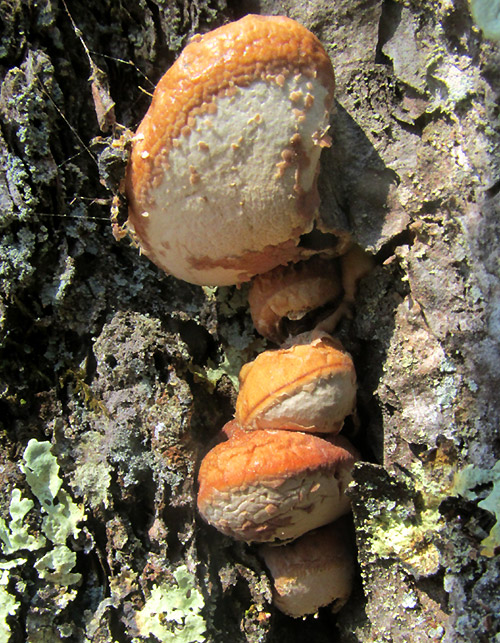Excerpts from Jim Conrad's
Naturalist Newsletter
Entry from field notes dated May 7, 2023, atop hill forested with pines and oaks about 1km east of Curva de la Doctorcilla, on unnamed road connecting Hwy120 and El Doctor; limestone bedrock; elevation ±2650m (8700 ft); Eastern Sierra Madre mountains of east-central Querétaro state, MÉXICO, (N20.88°, W99.62°)
VEILED POLYPORE ON DEAD PINES

Vast areas of oak-pine forest at the upper elevations of the Eastern Sierra Madres and other similar zones in Mexico have been attacked by pine beetles, killing untold numbers of trees. When I was volunteering at Sierra Gorda Biosphere Reserve headquarters in Jalpan, Querétaro in 2006 and 2007, already many mountain slopes were losing their pines to pine beetles, and today the problem continues unabated. At this location the above strange looking mushroom commonly is seen on the trunks of pines already killed by beetles.
At first I thought these mushrooms were just the beginnings of a large, tree-trunk-occupying shelf or bracket fungus such as the famous Chicken of the Woods mushroom we've often eaten in the US. However, these pine-trunk ones were so hard I couldn't dent them with a thumbnail, not soft like an emergent shelf fungus. Before leaving the above picture, notice that the bottom of the top fruiting body has holes in it.

Bottoms of the above mushrooms likewise displayed holes, which were irregular, with ragged rims, unlike the neat holes formed during a puffball's natural development. Such holes allow spores to escape. The lower surfaces of shelf fungi are perforated by many tiny pores through which the spores descend, but this pine fungus seemed neither a puffball nor to have the shelf-fungus's pores.
To gather more insight into what kind of being this was, more information was needed about it's interior structure. It was hard to dislodge one of these tough, hard mushrooms because they were so well lodged into their cracks. However, when one finally came loose and the very tough bottom was torn open, something astonishing was revealed.

At the right, the mushroom is being held upside down. The bottom covering has been torn away, so the flat surface exhibiting many holes is the bottom part of the mushroom cap from which in a polypore-type mushroom spores normally descend. Polypore-type mushrooms are those with pores like this, and usually but not always members of the Polypore Family, the Polyporaceae. This mushroom belongs to that family.
Here's how it all hangs together:
The large, irregular holes seen in the top photos form naturally, if not gracefully. When wood-boring beetles come searching for food, they pass through the holes and feed on the mushroom's body. In the above picture, the larger holes amid the porous surface are where hungry beetles burrowed into the fungus's body. Not only do the beetles find food when they enter the holes, but a cozy, relatively moist and protective environment.
When the beetles finally leave, spores carried on their bodies are directly transferred to the next tree food source, thereby sowing our fungus's spores right where they can germinate and live on dead wood, once the tree is killed.
Sometimes our mushroom grows on other conifer species, and not always on trees killed by wood-boring beetles. Freshly fire-killed or wind-downed trees also are eligible for hungry beetles and the spores they carry. Our mushroom seems to be one of the first mushroom species to begin the wood-rotting process, for it's rarely found more than a year or two after the tree has died.
Our mushroom is CRYPTOPORUS VOLVATUS, the genus name nicely describing its structural peculiarity: crypto- from the ancient Greek κρυπτός meaning hidden, poros from Latin meaning "an opening." In English often it's called the Veiled Polypore.
Veiled Polypores occur in forests with conifers in eastern and western North America, south through the uplands of Mexico but not into southern Mexico. In the genus Cryptoporus only two species are recognized, the other species inhabiting southeastern Asia. The two species are identical morphologically, but the Asian one produces smaller spores.
The tough covering over the bottom half at first glance seems an astounding evolutionary innovation. However, we're told that the covering is just an extension of tissue from the cap margin; it's a novel use of a commonly occurring, pre-existing piece of mushroom anatomy.
Since the 1400s, the Asian taxon of Veiled Polypore has been used in traditional Chinese medicine to alleviate asthma and bronchitis. In the 2014 study by Li Gao and others entitled "Cryptoporus volvatus Extract Inhibits Influenza Virus Replication In Vitro and In Vivo," it was concluded that "... the aqueous extract of Cryptoporus volvatus exhibits antiviral activity against influenza A virus in vitro and in vivo, and has the potential to be developed into a new antiviral agent."
What's good for bark beetles, but bad for pines, may be good for lungs, because it's bad for influenza A virus.